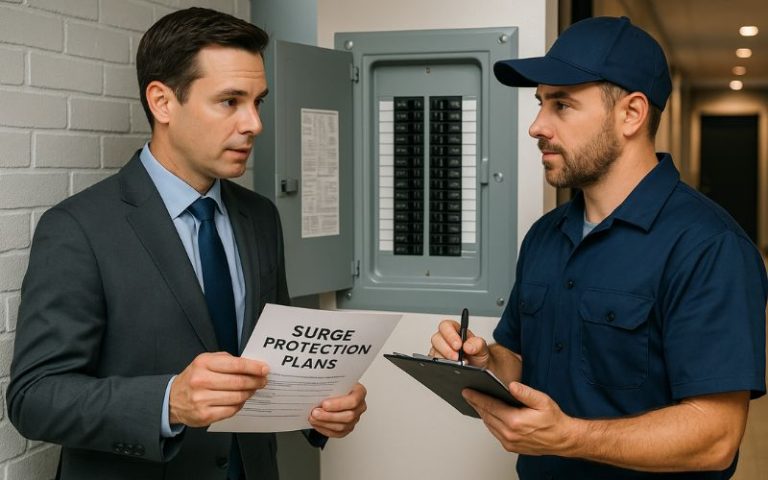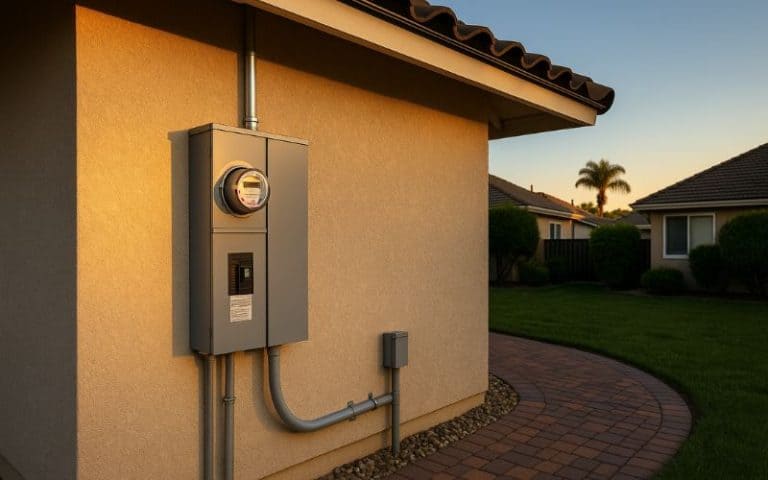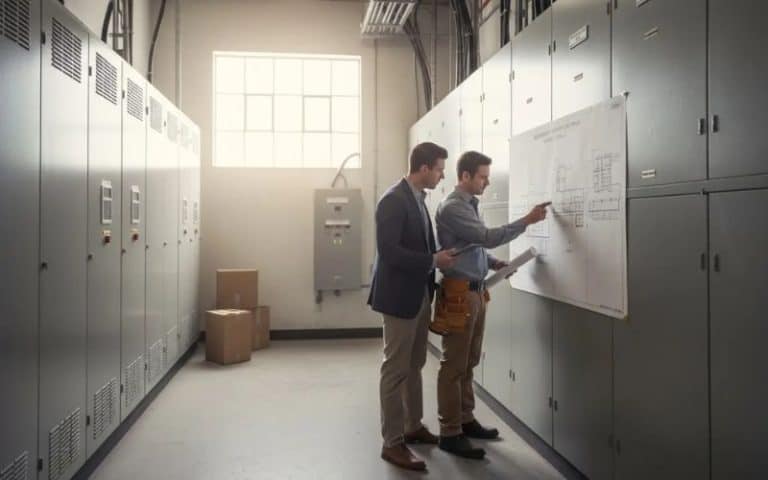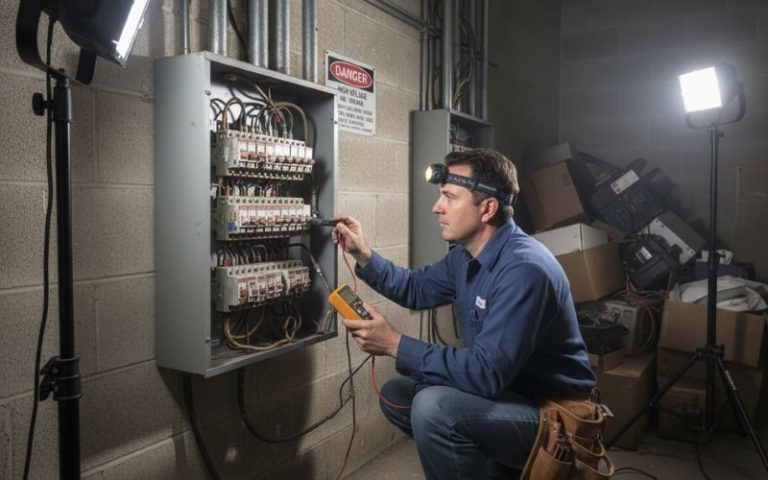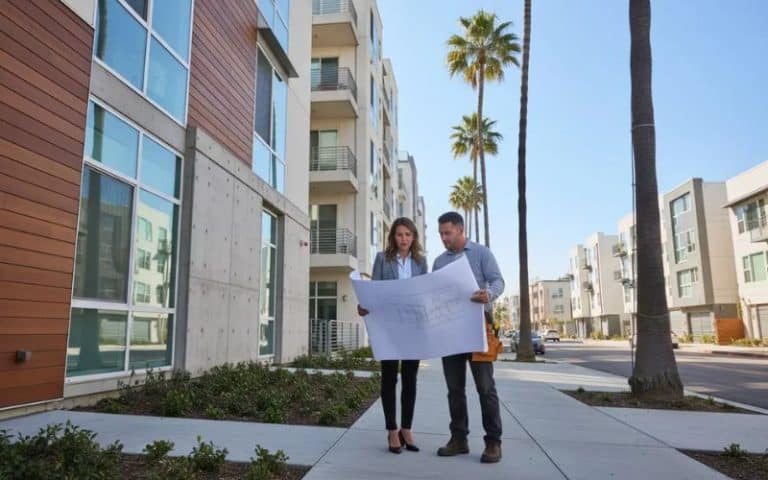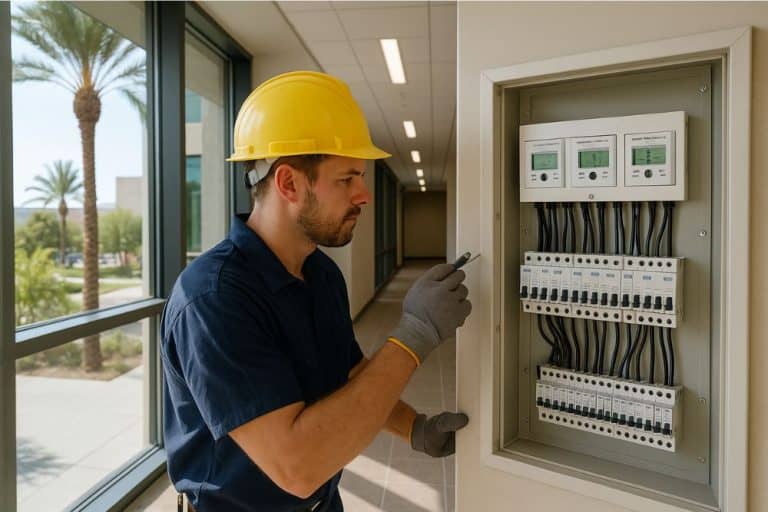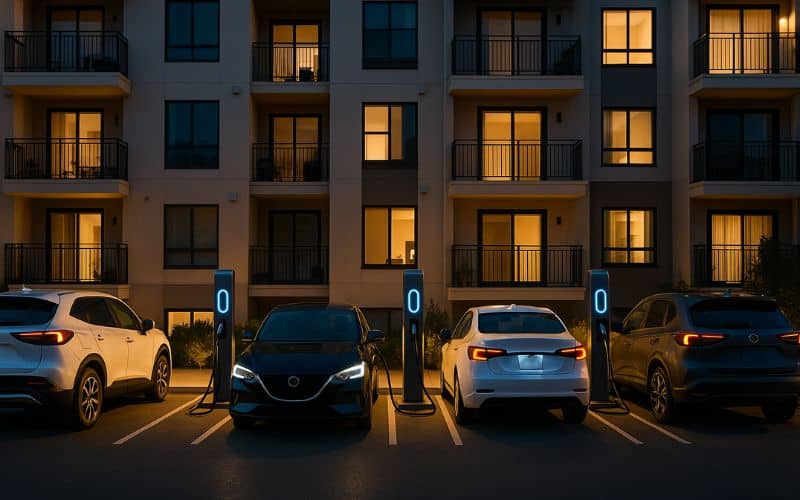
Why EV Charging in Apartments and Condos Is No Longer Optional
Electric vehicles are no longer a niche trend in Los Angeles. As California pushes toward full electrification, the city continues to lead in EV adoption, supported by strong state incentives, expanding infrastructure, and consumer demand. For property managers and HOA boards, this shift has created a new expectation, access to reliable EV charging within multi-unit buildings is becoming a must-have amenity.
The Changing Landscape of Tenant Expectations
More Los Angeles renters now own or plan to own an electric vehicle than ever before. According to LADWP data and regional studies, EV ownership has grown sharply across residential sectors, including apartments and condominiums. Tenants increasingly expect charging access to be available at home, not just at public stations.
For property managers, providing EV charging is no longer just a sustainability perk, it has become a key factor in tenant attraction and retention. Buildings that offer charging options tend to lease faster, maintain higher occupancy rates, and appeal to eco-conscious renters who prioritize clean transportation.
HOAs are also feeling this pressure. Condominium owners frequently request charging installations in shared garages or assigned spaces, and California law requires associations to respond reasonably to these requests.
Los Angeles Regulations Encouraging EV Access
The City of Los Angeles and the California Energy Commission have implemented building code updates that directly affect multi-unit property owners. Under Title 24 and CALGreen, new residential and mixed-use buildings must include a percentage of parking spaces that are “EV Capable” or “EV Ready.”
Even older buildings are seeing increased regulatory encouragement for retrofit programs. The Los Angeles Department of Building and Safety (LADBS) supports these retrofits with streamlined permitting procedures, helping property managers adapt existing electrical systems for EV use.
By proactively upgrading now, property owners stay ahead of compliance requirements and position their properties to remain competitive in a market that increasingly rewards sustainability and technology readiness.
Financial Incentives for Property Owners
EV charging infrastructure not only attracts tenants but can also qualify for valuable financial incentives. The Los Angeles Department of Water and Power (LADWP) offers rebates for EV charger installations in multi-unit dwellings, covering a portion of equipment and installation costs. Additional programs from the California Energy Commission (CEC) and Southern California Incentive Project (SCIP) provide further funding for qualified properties.
These programs can significantly offset upfront investment costs, especially when installations include load management systems or shared charging solutions. RG Electric’s team helps clients navigate these incentive programs, ensuring every project qualifies for maximum available benefits.
A Future-Ready Investment
Offering EV charging positions any property as future-ready. It signals that the building supports sustainability, convenience, and compliance, three qualities increasingly valued by tenants and insurers alike. EV infrastructure can also increase property value, with appraisers and buyers recognizing the added amenity as a key modern upgrade.
For property managers, the message is clear: buildings without EV charging risk losing competitive ground in the Los Angeles market. Installing EV chargers now prepares properties for long-term growth, sustainability compliance, and tenant satisfaction.
RG Electric specializes in designing and installing EV charging systems that meet Los Angeles code, satisfy LADBS inspection standards, and deliver long-term reliability for both tenants and building owners.
Understanding Electrical Load and Capacity Limits
Before installing EV chargers in Los Angeles apartment or condominium buildings, it is essential to understand how they affect the property’s electrical capacity. Electric vehicles draw significant power, and adding multiple chargers to an already strained electrical system can quickly push it beyond its design limits.
Many older Los Angeles buildings were constructed decades before the EV era. Their electrical panels and feeders were sized for lighting, HVAC, and appliances, not for dozens of high-amperage chargers operating simultaneously. That is why every EV project begins with a load calculation and capacity assessment.
Load Calculations and Panel Ratings
A load calculation determines whether the building’s existing electrical service can safely handle additional chargers. Electricians analyze all connected loads, including lighting, elevators, HVAC units, and common-area systems, and then calculate how much spare capacity remains.
In some properties, particularly those built before the 1980s, panels may already be near capacity. Adding even a few Level 2 chargers can overload circuits and trip breakers. When this happens, a panel upgrade or sub-panel installation becomes necessary.
Modern EV chargers typically draw 30 to 80 amps per unit. A building that installs several chargers must often increase its total service to 400 amps or more to maintain safe, stable operation. RG Electric’s licensed electricians perform detailed load calculations in accordance with California Electrical Code and LADBS standards to ensure each project meets both safety and capacity requirements.
Learn more about this process in Electrical Panel Services in Los Angeles.
The Role of Wiring and Conduit Infrastructure
Upgrading wiring is often a critical part of EV charger installation. Older aluminum conductors or undersized branch circuits may not be rated to carry sustained charging loads. To prevent overheating and voltage drops, RG Electric replaces outdated wiring with modern copper conductors rated for continuous current.
Conduit routing also matters. In multi-level garages, new conduit runs may need to extend hundreds of feet to reach all designated parking spaces. Proper design ensures efficiency, avoids clutter, and meets inspection requirements for accessibility and fire separation.
For details on professional conduit design and installation, visit Wiring Services in Los Angeles.
Understanding Peak Demand and Utility Coordination
EV chargers often operate during evening hours, the same time tenants return home and overall power usage spikes. Without proper management, this can strain both the building’s internal system and the local LADWP grid.
To prevent outages or service interruptions, RG Electric works with LADWP to confirm transformer capacity and distribution readiness. In some cases, properties may qualify for demand-response programs, where chargers automatically adjust during high-load periods to help balance the grid while saving energy costs.
Load Management Strategies for Multi-Unit Properties
Once a property’s electrical capacity is established, the next step is implementing load management, a smart strategy that distributes power evenly and prevents overloads when multiple EV chargers operate simultaneously.
For Los Angeles apartment buildings and condominiums, load management is often the key to making EV infrastructure financially and technically feasible without requiring full service replacements.
Dynamic Load Balancing
Dynamic load balancing systems monitor how much power each charger is using in real time. When total demand nears the system’s limit, the controller automatically reduces output to certain chargers or delays new sessions until capacity is available.
This prevents tripped breakers, protects wiring, and allows more chargers to operate on the same electrical service. It is an especially useful solution for multi-unit garages where not all tenants charge their vehicles at the same time.
By using smart algorithms, dynamic load balancing can increase charger availability by 30 to 50 percent without increasing overall electrical capacity.
Scheduled and Time-of-Use Charging
Another effective strategy is scheduled charging, which distributes energy usage across non-peak hours. Property managers can implement automatic schedules that delay charging sessions until late night or early morning, when building demand is lower and LADWP electricity rates are reduced.
This approach reduces strain on the system, lowers utility bills, and extends equipment life. Some advanced chargers also integrate with LADWP’s time-of-use programs, allowing tenants to save money while charging efficiently.
Intelligent Breaker Management
Modern EV systems can incorporate intelligent breaker panels that monitor power flow to each circuit in real time. These panels automatically prioritize essential services, such as lighting or elevators, and allocate remaining power to EV chargers.
This technology is particularly valuable for older buildings where full infrastructure upgrades are not immediately feasible. Intelligent breaker management allows property owners to add chargers incrementally, maintaining safety and compliance without overspending on initial service expansions.
Centralized Energy Management Software
For large apartment complexes or condominium associations, centralized energy management software can provide real-time visibility into usage patterns across all chargers. This allows property managers to identify trends, optimize charging schedules, and forecast future electrical needs.
RG Electric installs and configures these systems to align with LADWP monitoring standards and to comply with California Energy Code requirements. This ensures that every charger operates efficiently, safely, and within local inspection guidelines.
For comprehensive system design and commercial integration support, explore Commercial Electrical Services in Los Angeles.
LADBS Permits, Inspections, and ADA Compliance
Installing EV charging stations in Los Angeles is more than just an electrical project. It is a regulated process that requires proper permitting, code compliance, and accessibility planning. Property managers who understand how these requirements work can avoid costly project delays and ensure full approval from the Los Angeles Department of Building and Safety (LADBS).
The LADBS Permitting Process
Every EV charger installation — whether in a single condo garage or a 100-space apartment parking structure — requires an LADBS electrical permit. This ensures the work is performed safely and meets California Electrical Code and Title 24 standards.
The permit process typically includes:
- Load calculation review to verify system capacity
- Plan submission showing conduit runs, wiring methods, and charger locations
- Inspection scheduling for both rough and final installations
RG Electric manages this process from start to finish. Their licensed electricians prepare the required documentation, submit plans electronically, and coordinate directly with LADBS inspectors to confirm compliance. This proactive management minimizes delays and ensures every project passes inspection smoothly the first time.
Electrical and Fire Code Requirements
LADBS inspectors verify that all wiring, conduit, and panel connections meet city fire safety and clearance standards. This includes proper wire sizing, breaker labeling, and grounding verification. Chargers installed in parking garages must also maintain sufficient clearance for vehicles and emergency personnel.
RG Electric’s field crews ensure installations follow code exactly, including GFCI protection, dedicated circuiting, and surge suppression where required. These details protect property owners from code violations and liability risks.
ADA Accessibility and Parking Layout
Under California Building Code (CBC) Section 11B, EV charging installations in shared or public-access areas must include accessible parking spaces and compliant reach ranges for disabled users. LADBS enforces these standards during plan review.
For apartment and condo properties, this means at least one or more designated charging spaces must be ADA-compliant, with accessible paths, signage, and equipment placement within allowed height ranges.
RG Electric’s design team incorporates these requirements early in the planning phase, ensuring ADA compliance while maintaining optimal space utilization for all residents.
Coordination With LADWP and Local Incentive Programs
Because many Los Angeles properties are served by the Los Angeles Department of Water and Power (LADWP), coordination with the utility is also required. LADWP reviews electrical load impact and may provide rebates through its Charge Up LA! program for qualifying installations.
RG Electric coordinates directly with LADWP to ensure all applications, load calculations, and inspection results meet utility requirements for both approval and incentive qualification.
For comprehensive EV installation guidance, visit EV Charger Installation Services in Los Angeles to learn how RG Electric simplifies permitting and compliance for property owners.
Creating Fair and Effective Tenant EV Charging Policies
Once EV chargers are installed, property managers face a new challenge, establishing fair and enforceable rules for tenant use. Without clear policies, confusion over access, billing, and maintenance can quickly arise. Developing structured EV charging policies ensures smooth operation, cost recovery, and compliance with Los Angeles regulations.
Assigned vs. Shared Charging Access
The first decision property managers must make is whether chargers will be assigned to individual tenants or shared among multiple users.
- Assigned access works well in condominiums or apartments with deeded parking spaces, allowing residents to pay directly for installation or electricity.
- Shared access systems use networked chargers that track usage by account or RFID card, ensuring accurate billing for each user.
Shared models are ideal for large apartment buildings, where tenant turnover and flexible access are priorities. RG Electric installs chargers compatible with both approaches, offering scalable solutions for growing tenant demand.
Metering and Billing Options
Tenants should pay only for the electricity they use, and modern EV chargers make that possible. Networked units track energy consumption per user and automatically generate usage reports. Property managers can either integrate these with rent billing systems or use third-party platforms to collect payments.
For smaller installations, submeters can be added to measure each charger’s usage independently. LADBS-approved metering systems allow transparent billing while maintaining compliance with city electrical codes.
Policy Documentation and Tenant Agreements
Once access and billing are established, formal documentation is essential. EV charging policies should be written into lease agreements, HOA rules, or building management handbooks. They should clearly outline:
- Who can use the chargers
- How usage is billed or reimbursed
- Rules for parking, maintenance, and reporting damage
- Procedures for requesting new charger installations
Clear documentation protects both tenants and property managers from disputes while demonstrating proactive compliance with California Civil Code 4745, which governs EV charger rights and responsibilities in shared properties.
Maintenance and Usage Guidelines
EV chargers require occasional inspection and maintenance to ensure consistent performance. Property policies should specify how maintenance is handled, including inspection intervals, reporting procedures, and service response times.
RG Electric provides ongoing maintenance plans for multi-unit properties, including annual inspections, firmware updates, and safety testing. These services help property owners maintain operational reliability and pass LADBS re-inspections without interruption.
Communicating Sustainability Value
Beyond logistics, EV charging policies also serve as a marketing advantage. By highlighting energy efficiency, convenience, and environmental responsibility, property managers can promote their buildings as progressive, tenant-friendly communities.
When tenants see that their building supports sustainable living, satisfaction and retention improve, a win for both residents and property owners.
Budgeting and Incentives for EV Charging Infrastructure
For Los Angeles property managers and HOA boards, budgeting correctly for EV charging is key to balancing sustainability goals with financial responsibility. While initial installation costs can seem significant, incentive programs, energy savings, and increased property value often make the investment far more affordable than expected.
Cost Factors That Influence Installation
The total cost of EV charger installation depends on several elements, including:
- Electrical capacity upgrades: Older buildings often require panel or sub-panel expansion to handle additional load.
- Conduit and wiring distance: Long runs between the panel and parking spaces increase material and labor costs.
- Charger type and rating: Level 1 chargers are low-cost but slow, while Level 2 and networked chargers provide faster, managed service for multi-unit use.
- Permitting and inspections: LADBS permits, plan reviews, and post-installation inspections add administrative costs but ensure code compliance and safety.
- Networking and billing software: Cloud-based platforms for user management and reporting may include subscription or setup fees.
RG Electric provides transparent, itemized estimates that outline every cost component. Their team also helps identify opportunities to optimize infrastructure and reduce installation time.
Available Incentives and Rebates in Los Angeles
Several financial programs are available to offset installation costs for qualifying Los Angeles properties:
- LADWP Charge Up LA! Program
Offers rebates for both Level 2 and DC fast chargers, including additional funds for networked systems in multi-unit dwellings. - California Electric Vehicle Infrastructure Project (CALeVIP)
Provides statewide funding for commercial and residential properties that install publicly accessible chargers. - Southern California Incentive Project (SCIP)
Offers incentives for infrastructure upgrades, conduit trenching, and panel modifications to support EV charging in multi-unit developments. - Federal Tax Credit (IRC 30C)
Property owners can receive up to 30% of installation costs as a federal tax credit, subject to eligibility.
RG Electric assists clients through every step of the rebate application process, ensuring proper documentation and compliance with program requirements.
Long-Term ROI and Property Value
Beyond incentives, EV charging delivers strong long-term value. Properties with charging stations often command higher rents, experience lower vacancy rates, and attract tenants with above-average retention. For HOAs, offering shared charging also supports sustainability goals that appeal to environmentally conscious buyers.
Installing chargers today helps property owners avoid the higher retrofit costs expected in the future as regulations tighten and tenant demand increases. In Los Angeles’s competitive rental market, proactive upgrades like these protect property value while supporting citywide environmental initiatives.
Partnering With RG Electric for EV Charging Solutions
EV charging in multi-unit buildings involves more than electrical work. It requires expertise in capacity planning, permitting, accessibility, and tenant coordination. RG Electric brings all these elements together, delivering safe, efficient, and code-compliant charging solutions throughout Los Angeles.
End-to-End Project Management
From the initial assessment to final inspection, RG Electric manages every aspect of the project. Their licensed electricians handle load calculations, LADBS permit applications, wiring and panel upgrades, and final testing to ensure compliance.
For larger installations, RG Electric coordinates with LADWP, building management, and network providers to create seamless, scalable systems. Every installation is documented for insurance and inspection purposes, giving property owners peace of mind and reliable long-term performance.
Expertise in Multi-Unit and Commercial EV Infrastructure
RG Electric’s experience extends across all property types, from high-rise condominiums to large apartment complexes and mixed-use commercial buildings. They design systems tailored to unique electrical layouts, tenant usage patterns, and budget requirements.
Their technicians understand Los Angeles permitting timelines, ADA parking design, and energy code compliance, ensuring installations pass inspection smoothly and operate efficiently.
Support Beyond Installation
EV charging technology continues to evolve, and RG Electric provides ongoing support to keep systems updated and reliable. Their maintenance services include annual inspections, firmware updates, and performance monitoring. Property owners can also schedule future expansions as EV demand grows, without the need for costly redesigns.
Start Your EV Charging Project Today
Adding EV charging to your apartment or condo property is an investment in your building’s future, one that improves tenant satisfaction, supports sustainability, and boosts property value.
Call RG Electric at (323) 521-5131 or request a free estimate at https://www.rgelectric.net/contact-us/ to schedule your consultation. Let RG Electric design a load-managed, code-compliant EV charging system that works for your building and your tenants.
Safety Disclaimer
Electrical work is hazardous. Consult a licensed electrician like RG Electric for inspections, permits, and code-compliant installations. Do not attempt electrical modifications without proper licensing and approval from the Los Angeles Department of Building and Safety.


